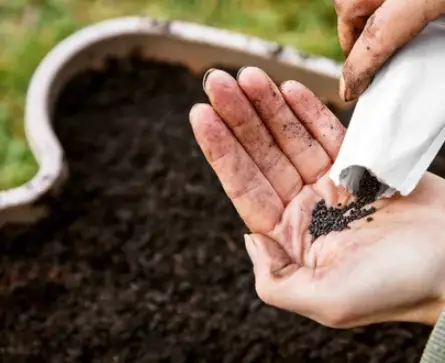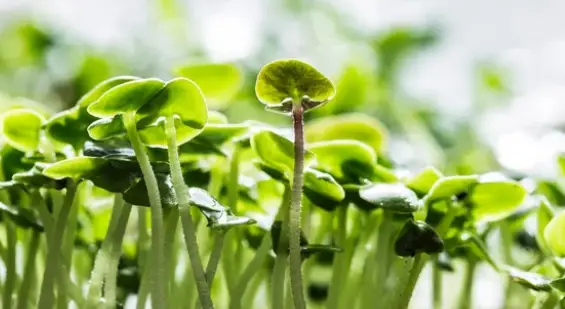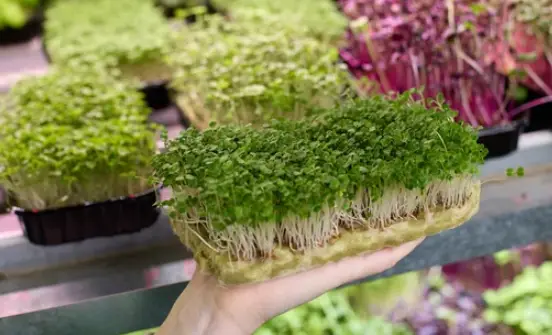Basil is a popular herb known for its sweet and savory flavor, making it a staple in many kitchens worldwide.
Growing basil from seeds is a simple and rewarding process that can save you money and ensure a fresh supply of basil year-round.
This blog post will walk you through the steps to successfully germinate basil seeds, providing tips and tricks along the way. So, grab your seed tray, potting soil, and basil seeds, and let’s get started.

Materials Needed
To germinate basil seeds, you will need the following materials:
- Basil seeds: Choose fresh, high-quality seeds for the best results.
- Seed tray or pots: A seed tray is ideal for starting many seeds, but individual pots will also work.
- Potting soil: Make sure to use well-draining potting soil, as basil seeds need good drainage to prevent mold and root rot.
- Water: Use room temperature water to water your seeds.
- Plastic wrap (optional): Plastic wrap can help to create a mini greenhouse effect and promote seed germination.
With these materials on hand, you’re ready to start the germination process!
Step by Step Guide On How to Grminate Basil Seeds

Here is a step-by-step guide on how to germinate basil seeds:
- Fill seed tray or pots with potting soil: Fill your seed tray or pots with potting soil and gently press down to eliminate air pockets.
- Sprinkle basil seeds evenly on the soil: Sprinkle your basil seeds evenly on top of the soil, making sure they are spaced out evenly.
- Lightly cover the seeds with soil: Use a light dusting of soil to cover the seeds, making sure not to bury them too deeply.
- Water the seeds gently: Water the seeds gently, taking care not to wash away the soil or disturb the seeds.
- Cover with plastic wrap (optional): Cover the seed tray or pots with plastic wrap if desired, to create a mini greenhouse effect and promote seed germination.
- Place in a warm, bright location: Place the seed tray or pots in a warm, bright location that is out of direct sunlight. Ideal temperatures for basil seed germination are between 70-75°F.
- Check regularly and water as needed: Check on your seeds regularly and water as needed to keep the soil moist but not waterlogged.
- Remove plastic wrap once seeds have sprouted: Once your basil seeds have sprouted, remove the plastic wrap to allow for proper ventilation.
Tips for Success

germinate basil seeds
Here are some tips for success when germinating basil seeds:
- Use fresh, high-quality seeds: Make sure to use fresh, high-quality seeds for best results. Old or low-quality seeds may have a lower germination rate.
- Keep soil moist but not waterlogged: It’s important to keep the soil moist but not waterlogged. Over-watering can lead to mold and root rot, which can harm your seedlings.
- Avoid direct sunlight until seeds have sprouted: While basil seedlings do need bright light, they should be protected from direct sunlight until they have sprouted and developed a few leaves.
- Provide proper ventilation: Make sure your seedlings have proper ventilation to prevent mold and promote healthy growth.
- Thin seedlings once they have a few leaves: Once your basil seedlings have a few leaves, thin them out so that each seedling has enough space to grow properly.
It’s important to keep in mind that different climates and growing conditions can affect the germination and growth of basil. If you’re unsure about the best conditions for growing basil in your area, consider reaching out to a local gardening organization or nursery for advice.
It’s also a good idea to experiment with different varieties of basil to find the ones that work best for your climate and growing conditions. Different varieties of basil can have different growing requirements, so it’s important to research the specific variety you’re interested in before starting your basil garden.
With patience and proper care, you can enjoy fresh basil year-round and bring delicious flavor to all your culinary creations.
Conclusion
Germinating basil seeds is a simple and rewarding process that can provide you with a fresh supply of basil year-round.
By following the steps outlined in this blog post and utilizing the tips for success, you’ll be on your way to growing your own basil garden. So, grab your materials, get your hands dirty, and happy gardening!




